Christopher Frese 1834-1904
Maria Louisa Frese 1828-1904
The weather report for the 28th of June 1904 called for partly cloudy conditions and “light and fresh, east to southeast winds.” It promised to be a little warmer than the previous three days when temperatures had hovered in the mid-60s. During the brief service at the late home of the deceased, No. 189 Burton Street, a throng of people, unable to gain admission to the little house which was already crowded, lingered about the property and streets until its conclusion, waiting for the later service at St. John’s Evangelical Protestant Church on Harbor Street. When the two hearses reached the church, even standing room could not be secured and many were unable even to enter the church.
The two caskets were borne simultaneously down opposite aisles of the church and placed side by side before the pulpit, The service was simple, consisting of prayer, scripture reading, and special singing by the choir. Rev. C. W. Weiss officiated, and made brief mention of the aged couple’s tragic end.
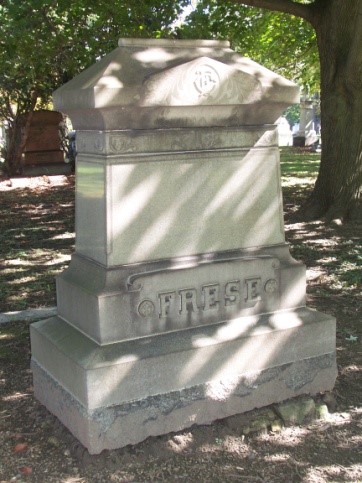
From the church, the procession proceeded to the Monroe Street Cemetery for the burial service. The procession was unusually long, over forty carriages being in line. The bodies were buried side by side.
Christopher Frese – or Christian as he was called in newspaper articles or Christoph as he is called in legal documents – was one of the wealthiest and best know residents of the district where he lived. He was an early West Side resident and made his fortune from investments in real estate. He lived on and owned much property on Burton Street, which today is West 41st Street, several business properties on Lorain and a number of residences on Ward Street. Frese Street – the street sign today reads “Freas” – was opened in the 1870s by Frese and several associates. They owned practically all of the property from one end to the other of the street. They sold the various properties at good figures realizing large profits. In addition Frese owned and operated a grocery store at 199 Burton street, which was later run by his son, August C. Frese.
Frese was a stalwart Republican and took much interest in political affairs. He represented the Tenth ward in the Cleveland City Council under Mayor Robert McKisson (1863-1915) who served as Mayor from 1895-1899. During the time that McKisson and Frese served their city, construction was begun on a new city water and sewer system, the Cuyahoga River was widened and straightened to facilitate steamer traffic, and five new bridges were built across the river. Frese served on a council committee on cemeteries and was partly responsible for the opening of West Park cemetery in 1900. During one session of the Grand Jury Frese served as one of the jurors.
Frese and his wife, Maria Louisa, were loved and respected residents of their community. They had brought two boys into this world, August and Frank. August seems to have taken after his father; a hard-working businessman and devoted father. Frank, on the other hand led a less than admirable life.
Tragedy
Since retiring from active business Christopher Frese had spent much of his time driving about the city and country. Maria Louisa generally accompanied him and their rig was a familiar one on Burton and the neighboring streets. “I tell you there is nothing so good for one’s health as plenty of rides in the open air,” Christopher had said frequently to his friends. In early June of 1904 when Christopher was seventy years old he suffered a paralytic stroke which affected the right side of his body leaving his right arm almost powerless. However, the damage done was not sufficient to keep Christopher on his back for very long. He lingered in the house no longer than absolutely necessary and the first day that he was able to move about found him in his buggy. His friends advised that he be careful, owing to his weakened and crippled condition, but he took their warnings with a complacent smile. “This old horse and I have traveled over this town for a good many years,” he said, “and I guess if anything was going to happen to us, it would have happened before this.” He was wrong.
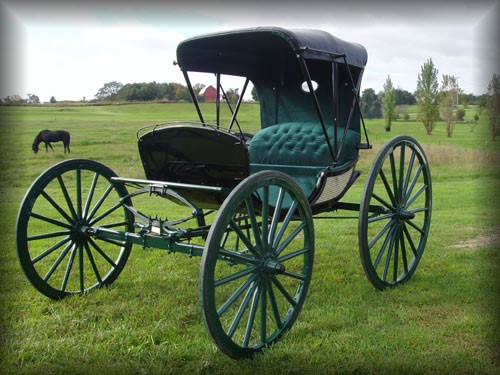
On June 26, 1904, Christopher and Maria Louisa headed out for yet another buggy ride into the nearby hamlet of Lakewood. The following day the Plain Dealer described what happened:
“Mr. and Mrs. Frese had been driving since they finished their Sunday dinner. Their vehicle was a phaeton of an old fashioned type and they drove a gentle and well trained horse. It is supposed that they had been driving along Lake avenue and intended to go through Belle avenue and return to their home by way of the boulevard.
As he drove across the tracks at Bell Avenue and Clifton boulevard about 2:30 o’clock yesterday afternoon, the buggy containing Christian Frese, a former city councilman, and widely known resident of the West Side, who lived at No. 189 Burton street, and his wife Louisa, was struck by a Lake Shore Electric car. Frese met instant death and his wife died a short time later in an ambulance on the way to St. John’s hospital.
The car which struck the buggy was bound west and according to the statements of eyewitnesses, was at a high rate of speed. A greenhouse is located at the corner of the boulevard and the street, but not close enough to the tracks to shut off the view of either those who are driving or the motormen. A hedge about four feet in height extends almost to the tracks, but this it is believed was not high enough to hide the buggy or the track from sight. Whether Frese did not notice the car or miscalculated the speed and tried to crosss in front of it is not known. The motorman, according to statements made at the company’s car barns, has as yet made no explanation of the accident.
Frese had nearly cleared the tracks when the collision occurred. Only a part of the buggy was on the tracks, but this was hit while the car was still going at almost the full speed. Hurled about sixty feet the buggy struck a feed wire pole and then glanced off into the road. Frese was carried beneath the wheels of the car and his body cut in two. The left arm was crushed and mangled and the right arm broken.
Mrs. Frese was thrown into the road about forty feet from where the phaeton was struck. When found, her head was resting upon the curb, less than half a dozen feet from the body of her husband upon the tracks. Her head was cut and bruised and her body crushed.
The motorman succeeded in stopping his car about 150 feet down the tracks and with many of the passengers, hurried back. Mrs. Frese, unconscious but still breathing, lay upon the road. She was carried to the side of the boulevard and Mastick’s ambulance was called. Mrs. Frese was hurried to the hospital, while the body of her husband was taken to the undertaking rooms. Before the hospital was reached the injured woman had expired. Her remains were also taken to Mastick’s undertaking rooms.
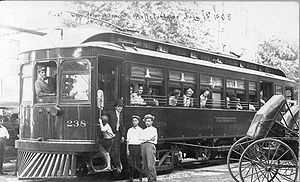
Aside from a ring upon the finger of Mrs. Frese, which bore the initials, C.F. to L.F, there was nothing about the body to lead to their identification, but through the initials upon the ring a clew to their identity was later gained. Telephone inquiries revealed the fact that the initials of Mr. and Mrs. Frese were similar to those upon the ring and that they had gone driving. A son was notified and early in the evening he recognized his parents as they lay side by side in the undertaking establishment.
The horse, which had been driven by the couple, was entirely uninjured. The harness had broken when the vehicle was hit and the horse released. It cantered down the boulevard, but was stopped and brought back. The buggy was entirely demolished. The wheels and body were splintered into small pieces and scattered about the boulevard.”
Interurban Cars
Prior to the accident there had been practically no complaints about the fast speed of the interurban cars, but on the day following the accident many complaints against the interurban companies were made to the board of public safety and Cleveland Police Chief Fred Kohler. Most of the complaints were against the Lake Shore Electric. County Coroner Burke directed that an inquest be held at which particular attention was to be taken to investigate the condition of the brakes with which the car that caused the deaths was equipped. Burke said, “I will probably have an expert make a thorough examination and test of the car which figured in the accident. If his report shows that the car was poorly equipped with brakes and that the brakes are not of a recognized modern standard, I will attempt to hold the company liable and will also make recommendations not only to that company, but to all other companies in this county to examine their brakes and install, where necessary, modern and efficient brakes. If they fail to do so and other accidents of like nature happen I can then easily hold them responsible. This has been the first accident of its kind to come to my notice, but modern science has perfected brakes which, if properly applied and used by intelligent men, will almost to a certainty protect people against accidents of this nature.”
It was no surprise when Warren Bicknell, president of the Lake Shore Electric Railroad said, “The brakes on the car that killed Frese and his wife were in the best of condition and they had passed a close inspection not only in the barns at Toledo before the car was sent out on the run, but also two other inspections between that city and Cleveland. That was not our accident, but that of the city company,” said President Bicknell last night. “The car is under the direction of the city company when it is on their tracks. When we turned it over to them the car and brakes were in good condition. . . . All of our cars are supplied with the best and most modern brakes and they are kept in perfect repair. The brakes on that car were installed only about a year ago, while the life of a car’s brakes generally is ten years or more.”
Brakes were one issue but equally important was the speed at which the interurban cars made their way through the city. The interurban lines connected cities at great distances from each other and revolutionized communications and travel. A majority of the distance on these journeys passed through farm country and speed was the key in getting someplace fast. In Cleveland however, an ordinance had been passed to restrict the speed of railway trains to a maximum of twelve miles per hour within the city limits. As a result of the complaints, Chief Kohler had a stretch of track a mile in length measured along the Lake Shore tracks in the eleventh precinct. Patrolmen Clenadenin and Whalen were detailed to watch. During the afternoon of June 28, 1904, the patrolmen found motormen Charles Holmes and Simon Purcell sending their cars at a rate of twenty miles an hour. Warrants for the two men were sworn out. The attention of the police was not confined to the Lake Shore Electric alone. All lines in the city were watched and arrests were to be made for any violation of the law.
Included in the Plain Dealer of July 2, 1904 was an article entitled “MOTORMEN WERE FINED.” It read: “The two motormen of the Lake Shore Electric who were arrested yesterday for violating the city speed ordinance with their cars, were yesterday fined $5.00 and costs by Police Judge Whelan. The Judge enjoined them to be more careful in the future and warned them that the ordinance would be severely enforced. The two men were Simon Purcell and Charles Holmes. The police of the Twelfth Precinct caught them several days ago speeding at the rate of twenty miles an hour in the city limits where only twelve miles is allowed.
The arrest of the two men was the outcome of the accident in which ex-Councilman Frese and his wife were killed last Sunday. The police are now making an effort to curtail the many liberties which the motormen are said to have taken with the city’s speed ordinance.”
The coroner’s inquest was held on July 6, 1904, and a witness testified that the air brakes on the Lake Erie Electric car were not in working order at the time of the accident. The testimony was from Irving Robinson of Beach Park, Ohio, who was the motorman of the ill-starred car: “My car was in good condition when I got it at Norwalk but coming into Cleveland at the corner of Superior and Water streets the wire to the air pump burnt out, leaving the air brakes useless. At the square I told the inspector of the condition of the air brakes, but he gave me orders to proceed, which I did, reversing my motors and using the hand brake to stop. I first saw Frese and his wife when within two hundred feet of them but I could not stop the car in time, and I don’t believe I could have done so if the air brakes had been working.” Robinson said he could only reverse his motors and use the hand brake to stop the car.
Two other witnesses, William Burns and Henry Muschwitz, both of whom were passengers on the car at the time the accident occurred, testified that they believed the car was traveling at about 30 miles per hour. The testimony obtained at the inquest led the Frese family to file suit against the railroad company for wrongful death. The suit was settled by October of 1904 and resulted in the railroad company paying $2,000 to the Frese family which appears to have been divided between August and Frank Frese.
Estate
Christopher Frese had been a successful businessman and had accumulated a substantial estate. When his will was probated the value of the estate was approximately $25,000. This would be the equivalent of around $620,000 in 2009. His will divided his estate among four grandchildren and his son August Frese. A sad but telling notation in the will reads: “My said son Frank J. Frese not to receive anything of my estate.” Apparently Frank was a disappointment, and probably an embarrassment, to his father as one can gather from these following three Plain Dealer articles.
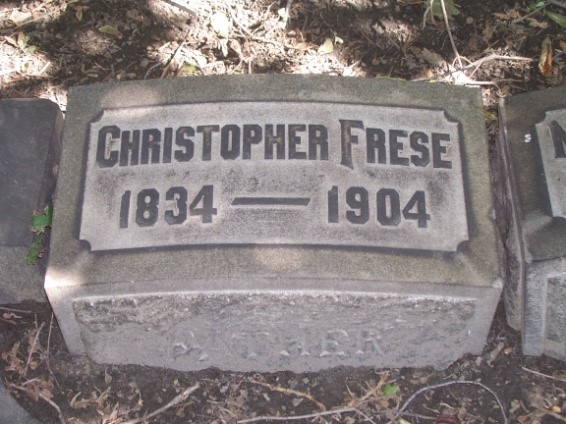
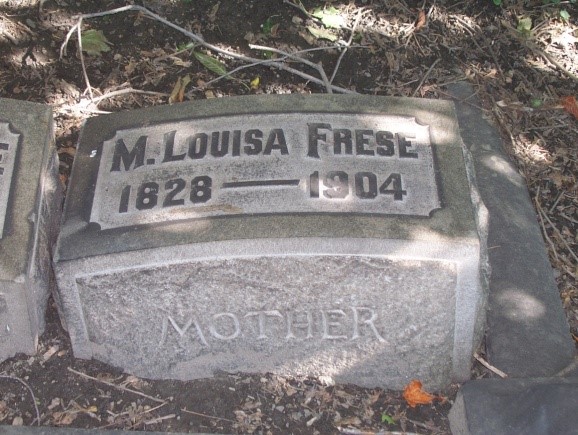
September 29, 1883: “Suit was commenced in common pleas court yesterday for a divorce by Minnie Frese against her husband, Frank J. Frese. They were married in May, 1890, and have one child. She accuses him of drunkenness, abuse and failure to provide. In addition to divorce she asks for alimony and custody of child.” (Frank and Minnie’s son Edward was included in Christopher Frese’s last will and testament.)
December 21, 1893: “Judge Hutchins took occasion Thursday morning to deliver to Frank Frese an exposition on the duties of man towards his wife regarding supporting her. Minnie Frese sued him for divorce, and pending proceedings, the court made an order allowing her alimony. Frese failed to observe the mandate of the court, and he was brought before Judge Hutchins to show cause why he should not obey.
He appeared before the court as a well dressed, well fed and intelligent looking man, and offered as explanation for his conduct that he was doing the best he could. He is out of work and not earning any money. Judge Hutchins told him it was the opinion of the court that it was disinclination that prevented his earning any money. He lives with his parents and does not want to work. The court would give him four weeks in which to manifest a disposition to secure work and support his wife. At the end of that time if he has done nothing he stands a good chance of going to jail.”
April 25, 1894: “Frank Frese answered the divorce petition of Minnie Frese yesterday and asks the court to dismiss her petition on the ground that she was the aggressor in all of their numerous family quarrels. The defendant admits that he engaged in several quarrels with his wife and on one occasion threw the handle of a flat iron at her but says that the missile failed to take effect and that she was as much at fault for their quarrel as he was. He also states that his wife and her mother had a pet scheme on foot to try and influence his father to deed to him and the plaintiff a house and lot and they sought to get the defendant to influence the father to do this, but that he refused to do so and this had caused family trouble. He thinks that he and his wife could get along very nicely if they were not interfered with in any manner.”